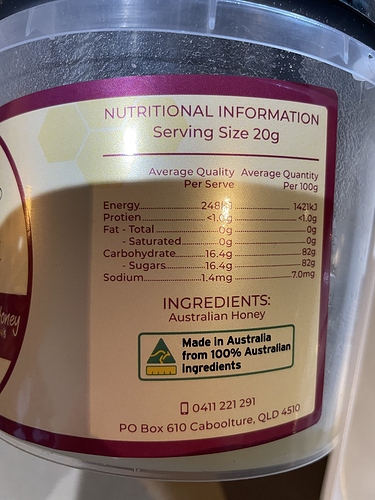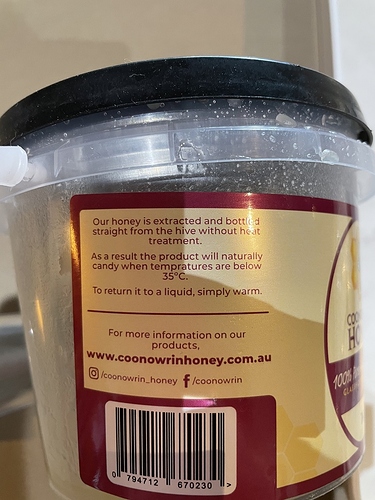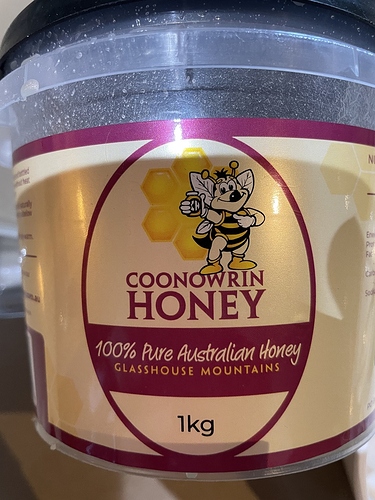We purchased 1kg x 4 tubs of honey from this company. We were told that it came from the flowers of Mango, Apple Blossom, Orange Blossom & (Pineapple - they do have an explanation for this one). The taste is Mango, Apple & Orange. This is not possible without an additive of these flavours. We emailed them to ask ‘What the chemical/ingredient is used that is not on the label’ After several weeks have not had an answer. We know that honey sourced from these ‘trees’ do not taste exactly like the fruit! Could you please ask this company to label their honey correctly with the additive listed.
Their web site is undergoing maintenance right now so I cannot see a label to understand how their claims are made.
Might it be like wine? An example of a tasting, and we know these are not in the ingredients list.
…begins with raspberry and cassis leading the aromatics, with soft hints of butterscotch. The red fruits are rich with layers of toffee and coconut weaving through the darker plummy fruit that fills the palate. Mocha and spice…
I trust you have already done so, and we look forward to your posting their response.
Honey naturally contains many compounds that give aroma and taste depending on the original source of the plant material.
Why would you expect these to be listed on the label? Why would you think these would have to be additives?
I guess I was expecting those claims on the label. So how were ‘you told’ and by whom?
Did they say that or is it what you tasted?
If they said it, it is true if the honey the bees make is sourced from these trees (including pineapple?). The honey from the flowers on these trees will have a distinctive taste unique to those trees. The honey is made by bees from flower nectar and not from the fruit, so the taste will be different to the fruit as nectar is different to fruit, and the bees do their ‘magic’ to nectar to make it honey.
Something which is a little bit odd is mango, apple & oranges are generally grown in different regions. Mangoes in northern tropical and subtropical areas, apples in cooler temperate areas and oranges in a wider range of climates. Pineapples are mostly grown in the Glass House Mountains area. It suggests the honey may be a blend of mango, apple & orange (+ pineapple?) honeys rather than a single hive honey.
Hi Gregr, Honey does not naturally taste like the fruit/flower the bees collect the nectar from. It has to have a flavour added to get that taste. Problem being if a consumer was allergic to the additive and it is not on the label they could be ill. Any flavouring additive needs to be on the label. You can check with the Honey Board or DPI.
Individual honeys from different plant sources contain over 100 volatile organic compounds (VOCs), which play a primary role in determining honey flavors and aromas.[67][68][69] VOCs are carbon-based compounds that readily vaporize into the air, providing aroma, including the scents of flowers, essential oils, or ripening fruit.[67][69] The typical chemical families of VOCs found in honey include hydrocarbons, aldehydes, alcohols, ketones, esters, acids, benzenes, furans, pyrans, norisoprenoids, and terpenes, among many others and their derivatives.[67][69] The specific VOCs and their amounts vary considerably between different types of honey obtained by bees foraging on different plant sources.[67][68][69] By example, when comparing the mixture of VOCs in different honeys in one review, longan honey had a higher amount of volatiles (48 VOCs), while sunflower honey had the lowest number of volatiles (8 VOCs).[67]
VOCs are primarily introduced into the honey from the nectar, where they are excreted by the flowers imparting individual scents.[67] The specific types and concentrations of certain VOCs can be used to determine the type of flora used to produce monofloral honeys.[67][69] The specific geography, soil composition and acidity used to grow the flora also have an effect on honey aroma properties,[68] such as a “fruity” or “grassy” aroma from longan honey, or a “waxy” aroma from sunflower honey.[67] Dominant VOCs in one study were linalool oxide, trans-linalool oxide, 2-phenylacetaldehyde, benzyl ethanol, isophorone, and methyl nonanoate.[67]
I am now wondering if the honey is from mango, apple or orange trees, or as @PhilT indicated, the underlying tones identified by a professional honey taster (similar to wines). It appears from their Facebook page, the honey is sourced from forests in the Glass House Mountains area (‘Our honey is collected from the pristine forests of Beerwah’). If this is the case, it tends to lead towards natural background flavours/tones identified by someone…rather than addition of mango, apple or orange trees flavouring.
Maybe ask a question of them on their Facebook page to get a definitive answer.
Hi phb, There is no way that the “Pristine forests of Beerwah” have Orange, Mango, Apple trees etc within them. Even IF they have a few, the honey would be a mixture of same. Bees do not only collect from ONE type of tree Unless it is in big numbers, then the combs must be taken from the hive before the blossom runs out & they go to another lot of trees & mix the variety. The bees would collect nectar from a number of different trees in the forest and this would vary in taste depending on the time of year.
What’s on the other part of the label may also be useful for comment.
Does the label read ‘Coonowrin Honey’ which I can find several references to or ‘Honey by Coonowrin’?
Coonowrin Creek is my backyard - literally.
Exotic - (European) honey bees and hives are common in the local forests. The area is predominantly ‘slash’ pine forestry, with small pockets of remnant vegetation and national parks. As to fruit, pineapples, strawberries and macadamias are common. There are only a few mango and citrus plantings, but not sufficient IMO to be significant.
The local honey we purchase from several local producers is generally ‘mixed blossom’.
As others have suggested describing the flavours may be different to the food sources of the bees. I’d suggest the majority of the local bee food comes from invasive weed flowers and native plant species including cultivated macadamia. The local acacia (wattles) and native wildflowers are busy with bees at present.
Agree. The area of National Park is very limited. 99% has been logged, and is far from pristine. There are also limitations on the use of National Parks for bee keeping, as the European Bees compete with native insects for resources.
P.S.
Oranges, mandarins and limes can grow well here, but no one I know grows apples.
Absolutely correct Mark. I give up, we know it is not possible to source these honeys in the forest of Beerwah. It says Coonowrin Honey on the label and the shop we purchased from assured us of the ‘natural’ flavours. We have told her it is not possible. We are happy with the flavours just want Coonowrin Honey to label them properly… Would not have started this conversation if they had answered our email. Please everyone NO more replies from me, have to work 
I think you are thinking that ‘natural flavours’ means that something has been added. Natural flavours can also mean natural undertones in a honey which provide flavour like those described above (and are similar to those used by the wine industry).
This is puffery. If they place their hives in the ‘pristine forests of Beerwah’, then they an claim that that is where they sourced the honey from. Technically nothing is pristine, but this is a common puffery term to make something sound better, healthier or less contaminated.
Certainly CHOICE could ask them to change their labelling if it is incorrect, CHOICE however has no legal authority to compel them to change it if it is incorrect or misleading.
As the complaint is about food labelling you can contact Public health units | Queensland Health as they are the responsible Authority in Qld for these matters and are authorised under the FSANZ Act to deal with these matters I understand per this page of the FSANZ’s page
https://www.foodstandards.gov.au/about/foodenforcementcontacts/pages/queensland.aspx
You may also wish to make a complaint to the ACCC re deceptive or misleading conduct by the producers or retailers.
I believe the OP was of the opinion that honey had to have additives to give it its flavour.
No, honey is a natural product, so I would think seeking remedies to various food standard authorities would be ignored.
Possibly but I was basing my post on the following from the OP
“ We were told that it came from the flowers of Mango, Apple Blossom, Orange Blossom & (Pineapple - they do have an explanation for this one).”
As I can’t see the front label I am taking that this may be on the front. However if they were told misleading information by the seller this as I noted may be a case for the ACCC regarding deceptive or misleading conduct.
One more answer from me. I definately do not think honey has to have additives to give it flavour. The ‘flavour’ comes from the different trees etc the bees collect the nectar. I love Tea Tree & Tasmanian Leatherwood so I know exactly what honey tastes are like. I will try & attach all the labelling on the “Mango” honey for you.
It is possible that the food standards do not require details about an added flavouring to be included on the label, see ANZ Food Standards Code 1.2.4.
However Honey has it’s own listing in 2.8.2 and honey is a prescribed name and has a very specific definition.
“honey means the natural sweet substance produced by honey bees from the nectar of blossoms or from secretions of living parts of plants or excretions of plant sucking insects on the living parts of plants, which honey bees collect, transform and combine with specific substances of their own, store and leave in the honey comb to ripen and mature.”
It would seem adding something even allowed without descriptive elements would be incongruous with that very specific definition.




